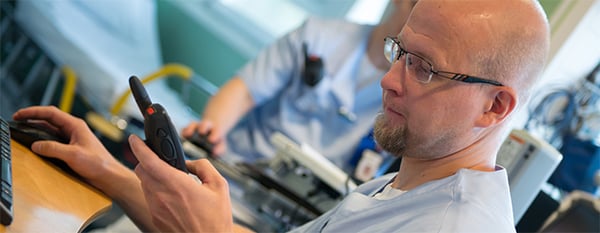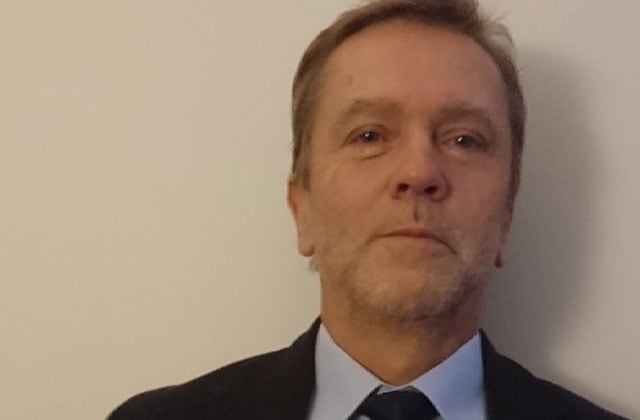- Segments
- Products and solutions
- Products and solutions
- Broadband
- Devices and accessories
- Applications
- Control Rooms
- TETRA and Tetrapol
- Customers
- Ecosystem
- How to buy
- Blog
- EN
“We will see more data being gathered and transferred as people self-monitor their health using sensors to make measurements at home. This will become part of everyday care and will bring new challenges as patients will know more and ask trickier, more difficult questions.”
In Finland, emergency calls from the public come into one of six dispatch centres of the National Dispatch Authority which coordinate the responses from different public safety agencies.
In Finland, TETRA has been used since 2002 to support all authorities, including police, fire and rescue, and emergency medical services, who manage their own talk groups independently. They have also created talk groups between agencies to enable closer collaboration.
Over the past five years we have implemented new technology capabilities over TETRA that enable alerts from ambulances to hospital emergency departments and various response teams, activating them and enabling them to communicate in the groups. This is a very reliable service that has never failed even in the most extreme events.

In the capital area, we have electronic patient recording in Emergency Medical Services (EMS) creating patient charts including data from patient monitoring devices transferred into the central hospital. This will be extended to nationally cover all EMSs in 2020 / 2021. In the future, we will see a boom in the use of medical gadgets in homes with sensors communicating with hospitals.
Being able to assess patients at distance is a huge benefit also for pre-hospital treatment. A good example is the care of patients suffering a stroke. Paramedics do not typically have the required neurotherapy knowledge to consider important differential care decisions, yet being able to start correct treatment immediately is critical to the recovery of a stroke patient. Data monitoring and video streaming allows the patient to be assessed remotely by specialists in the hospital so the right treatment can be established and decisions made on which hospital the patient should be taken to for the best care.
With advances in technology, such capabilities can be explored further. The benefits are enormous, both in the patient receiving the right care at the right time for a faster recovery, as well as in the cost of care for their rehabilitation.
We haven’t yet seen all the possibilities. The availability of more advanced broadband communications technology will create new uses and generate greater demand.
There are some concerns around patient privacy because Finland has very strict legislation that does not for example, allow EMS providers the filming of people in their homes without their consent, which they may not always be able to give. It is vital to protect sensitive patient information.
On the other hand, 80% of EMS patients are stable and there is no need to transfer video or images of them. But when specialist skills are required, then the capability needs to be available.
Data is neutral and of no value until it has been processed and analysed. Then it becomes knowledge and useful information.
There are real opportunities. In Finland, we are building a national data system that will store and share EMS data and inform professionals about their performance. So, when I finish a shift I will be able to see information about what I have done, statistics on responses, and this will enable us to identify ways to improve. Getting fresh feedback is valuable.
Furthermore, we will see more data being gathered and transferred as people self-monitor their health using sensors to make measurements at home. This is increasingly becoming part of everyday care and will bring new challenges as patients will know more and ask trickier, more difficult questions. On the other hand, it will also increase the demand for services.
The new generation of users don’t need much technology training as they are used to the latest technologies. They live in a different world; we don’t even have books in medical school anymore and exams are electronic-based.
Their technology knowledge can be a great facilitator. They are eager. They know no barriers and are confident when new technology is implemented, more so than more senior members of staff may be. They want systems to be supportive and do not expect to have to adapt how they work; the system must be configured to their needs.
However, it is difficult to get new people coming into the profession involved in and committed to developing systems. Younger doctors want to be hands on, gaining medical experience and don’t see the value of developing new systems. But then as they become more experienced, they will help in development and think more about the new possibilities.
Take a look at the 15 most interesting observations from all the interviewees gathered into a printable document. Get the pdf and print out the quote that most inspires you -
The views and opinions expressed herein are those of the interviewee and do not necessarily reflect the official policy or position of Airbus.
Dr Silfvast is an anaesthesiologist with a subspecialisation in critical emergency and intensive care medicine at the Helsinki University Central Hospital. He has a long working history from prehospital physician ground and HEMS units and is currently chief medical officer at the preparedness unit of the university hospital district. Besides medical preparedness planning, EMS system coordination and cooperation with joint authorities are part of the daily work.

Dr Tom Silfvast, Helsinki University Central Hospital